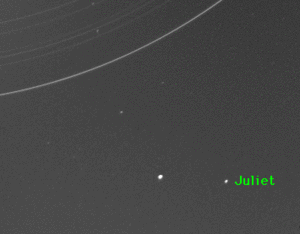Juliet (moon) facts for kids
| Discovery | |
|---|---|
| Discovered by | Stephen P. Synnott / Voyager 2 |
| Discovery date | January 3, 1986 |
| Orbital characteristics | |
| 64,358.222 ± 0.048 km | |
| Eccentricity | 0.00066 ± 0.000087 |
| 0.493065490 ± 0.000000012 d | |
| Inclination | 0.06546 ± 0.040° (to Uranus' equator) |
| Satellite of | Uranus |
| Physical characteristics | |
| Dimensions | 150 × 74 × 74 km |
|
Mean radius
|
53 ± 4 km |
| ~35,000 km² | |
| Volume | ~632,000 km³ |
| Mass | ~8.2×1017 kg |
|
Mean density
|
~1.3 g/cm³ assumed |
| ~0.016 m/s2 | |
| ~0.040 km/s | |
| synchronous | |
| zero | |
| Albedo | 0.08 ± 0.01 |
| Temperature | ~64 K |
Juliet is one of the inner moons orbiting the planet Uranus. Scientists discovered it using pictures taken by the Voyager 2 spacecraft. This discovery happened on January 3, 1986.
When it was first found, Juliet was called S/1986 U 2. Later, it was officially named after the main female character from William Shakespeare's famous play Romeo and Juliet. It is also known as Uranus XI.
Juliet's Family of Moons
Juliet is part of a group of moons called the Portia Group. This family of moons also includes Bianca, Cressida, Desdemona, Portia, Rosalind, Cupid, Belinda, and Perdita.
These moons share similar paths around Uranus and reflect light in similar ways.
What We Know About Juliet
Scientists don't know much about Juliet beyond its orbit and size. It has a radius of about 53 kilometers (about 33 miles). Its surface is quite dark, reflecting only about 8% of the sunlight that hits it. This is called its geometric albedo.
When Voyager 2 took pictures of Juliet, it looked like a stretched-out object. Its longest side points directly towards Uranus. Scientists describe its shape as a "prolate spheroid," which means it's shaped like a rugby ball or an American football. This shape is quite unusual for a moon. Juliet's surface appears to be grey in color.
See also
 In Spanish: Julieta (satélite) para niños
In Spanish: Julieta (satélite) para niños


